Ancient Stones of Alba (Scotland ).
Replies to This Discussion
-
Permalink Reply by Ghillie Dhu on October 20, 2018 at 9:27am
-
One of the main roads to the Scottish Highlands is the A82 which carries travellers from Glasgow to Inverness via Fort William. After leaving the outskirts of Glasgow, this well-known highway passes Dumbarton and Alexandria before running north along the side of Loch Lomond. The loch is eventually left behind as the A82 continues onward through Glen Falloch to Crianlarich and Tyndrum.
High up on the western slopes of Glen Falloch, on the opposite side from the picturesque Falls, stands Clach nam Breatann, ‘The Stone of the Britons’. Like a space-rocket ready to launch, this enigmatic monument leans up from its base to point towards the sky. The topmost piece or capstone rests on deep-set boulders that seem to grow out of the ground. These foundations are sunk so deeply in the hillside that they might indeed be a natural rocky outcrop. The whole assemblage sits on a conical mound of earth and stone which appears to be partly man-made, like a large cairn now covered with grass.
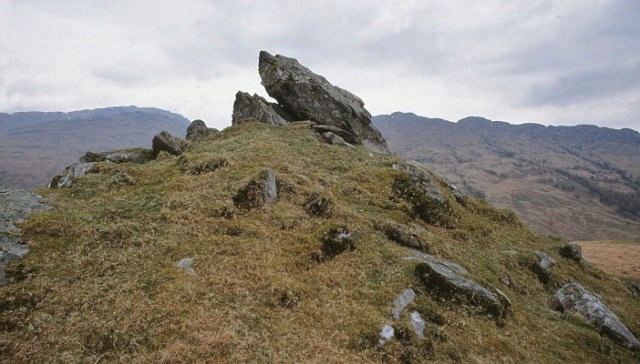
Clach nam Breatann (© David Dorren 2002)
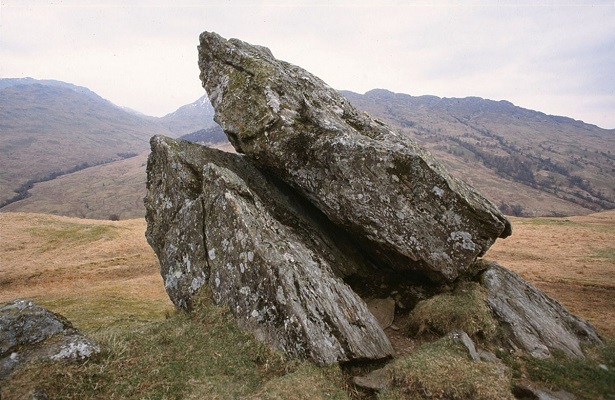
Clach nam Breatann (© David Dorren 2002)
Tradition asserts that Clach nam Breatann marked the boundary between Picts, Scots and Britons. Its association with the latter suggests that it lay within their territory and therefore belonged to them in some way. Historians generally assume that it defined the northern limit of the kingdom of Alt Clut or Dumbarton (c.400-870 AD) and also of the successor realm Strat Clut or Strathclyde (c.870-1070). The assumption is no doubt correct, although we should also keep in mind the possibility that the stone simply commemorated a famous battle involving the Britons. In the nineteenth century, the Scottish antiquary W.F. Skene suggested that an unidentified ‘Stone of Minuirc’, scene of a battle between Scots and Britons in 717, may have been Clach nam Breatann. The geographical setting of Glen Falloch would certainly be consistent with a frontier clash between opposing forces from Dál Riata and Clydesdale, but Skene’s theory was only a guess and Minuirc remains elusive.
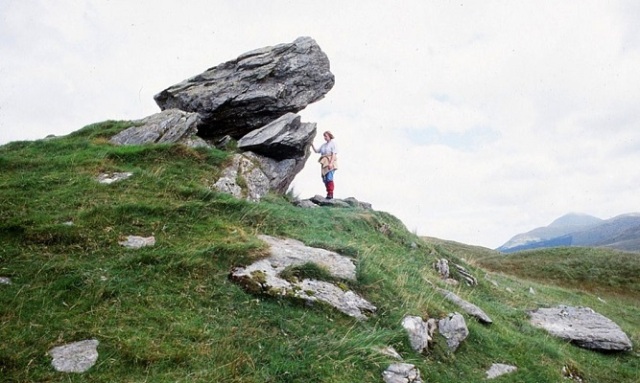
Clach nam Breatann (© David Dorren 1998)
I visited Clach nam Breatann some fifteen years ago. I had never seen anything quite like it before. Not only did it look imposing and ancient, it also had a strangeness, an eccentricity, that I found hard to explain. Since then, I’ve mentioned the stone in my book The Men of the North (with an accompanying photograph) and in several posts at this blog. I would like to make a return visit, to refresh my memory and to take more pictures. Getting there is by no means easy, for the approach involves a trek up a steep hillside over rough, boggy terrain. However, the effort is definitely worth it, especially on a clear day when the view is truly breathtaking.
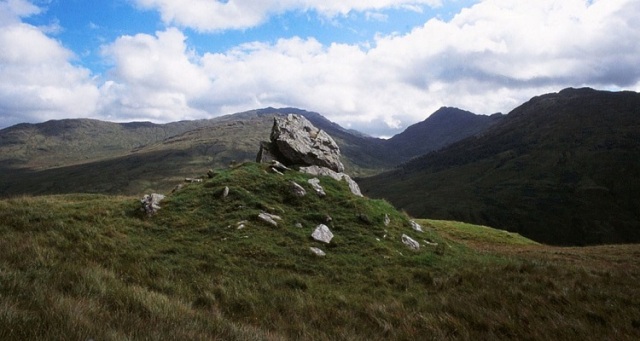
Clach nam Breatann (© David Dorren 1998)
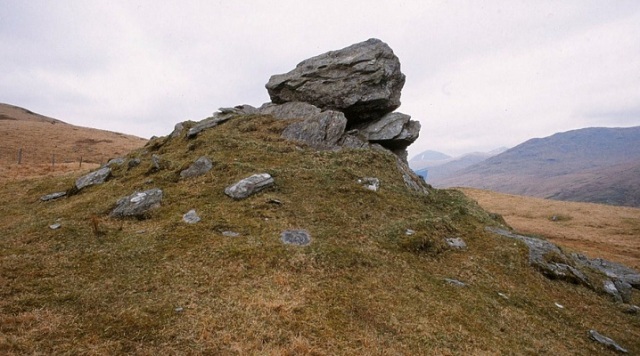
Clach nam Breatann (© David Dorren 2002)
As well as re-visiting Clach nam Breatann, I’m keen to see another impressive landmark for the first time. This is a gigantic boulder known as Clach A’ Bhreatunnaich, ‘The Briton’s Stone’, a glacial erratic nestling on the southern flank of Ben Donich near Lochgoilhead. As with Clach nam Breatann, tradition asserts that this solitary megalith stands on an ancient boundary between the Clyde Britons and their neighbours – in this case, the Scots of Cowal. Both stones may in fact be part of a single frontier – they are, after all, only 12 miles apart. The possible course of such a divide was traced by the late Betty Rennie who published her findings in the Pictish Arts Society Journal in 1996 (see reference below). Rennie’s pioneering work on ancient boundaries has been continued by two of her former colleagues in the Cowal Archaeological Society – David Dorren and Nina Henry – whose research on the mysterious Druim Alban (‘Ridge of Alba’) was highlighted in an earlier post at this blog.
The following images of Clach A’ Bhreatunnaich give a good idea of its size and of its position in the landscape.
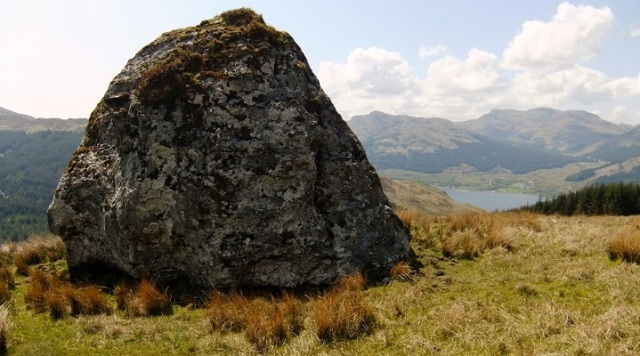
Clach A’ Bhreatunnaich (© David Dorren 2010)

-
-
Permalink Reply by Ghillie Dhu on October 20, 2018 at 9:36am
-
-
Permalink Reply by Ghillie Dhu on October 20, 2018 at 9:41am
-

-
-
Permalink Reply by Ghillie Dhu on October 20, 2018 at 9:44am
-
his impressive standing stone can be seen just a few yards from the minor road that winds through Glen Lonan, to the south of Taynuilt in Argyll.
Also called Diarmid’s Pillar or Clach Diarmid, It’s smothered with lichen and appears very weather-worn, so it’s difficult to imagine how it looked in its original state.
-
-
Permalink Reply by Ghillie Dhu on October 20, 2018 at 9:45am
-
Described by various history sources as a Bronze Age monolith or menhir, the granite stone measures over 13 feet (4 metres) in height, and is said to mark the grave of an Irish hero called Diarmid or Diarmuid.
Diarmid seems to have been an enigmatic figure in folklore, and any facts about him are hopelessly entwined with myth. He is reputed to have been a member of the Fianna, a legendary warrior band, and he fell in love with a princess called Grainne. But Grainne was promised in marriage to Fionn, the leader of the Fianna. The tale takes many forms, some ending in Diarmid’s untimely death during a boar hunt.
The Highland history website Am Baile describes Clach na Carraig as “one of the most impressive standing stones in Argyll”. Close by is a kerb grave or cairn, marked by 12 large stones, and to the north is a stone circle comprising 31 rounded boulders.
-
-
Permalink Reply by Ghillie Dhu on October 20, 2018 at 9:47am
-
Have questions?
Need help? Visit our Support Group for help from our friendly Admins and members!
Have you?
Donations & Sponsorship
Connect
Visit The Temple
on Facebook:
Blog Posts
Blessed Imbolc
Posted by Zhan on January 30, 2025 at 9:44pm 0 Comments 1 Like
Channeled Angelic Wisdom of the Jewels of Truth Series on Free Will and Sublime Gratitude
Posted by Atrayo on January 28, 2025 at 4:19pm 0 Comments 1 Like
CHAOTIC PEACE?
Posted by Rosey Cross on January 26, 2025 at 5:58pm 0 Comments 0 Likes
HEART CHAKRA GREEN!
Posted by Rosey Cross on January 26, 2025 at 5:51pm 0 Comments 0 Likes
Channeled Angelic Wisdom of the Jewels of Truth Series on Omni-Lives and The God Spark Within
Posted by Atrayo on January 25, 2025 at 3:05pm 0 Comments 1 Like
OUR TIME!!!
Posted by Rosey Cross on January 15, 2025 at 5:29pm 0 Comments 0 Likes
THE SACRED ROSE!
Posted by Rosey Cross on January 14, 2025 at 6:21pm 0 Comments 0 Likes
ENOUGH! TIME TO SPEAK!
Posted by Rosey Cross on January 10, 2025 at 5:17pm 0 Comments 1 Like
POMBAGIRA MARIA PADILLA a.k.a. Pomba-Gira Maria Padilha
Posted by Sky a.k.a. JD Aeon on January 1, 2025 at 7:29am 7 Comments 1 Like
Happy New Year 2025
Posted by Zhan on December 31, 2024 at 12:04pm 0 Comments 1 Like
Channeled Angelic Wisdom of the Jewels of Truth Series on Beyond Good & Evil and Why Souls Are Reborn
Posted by Atrayo on December 31, 2024 at 1:30am 0 Comments 2 Likes
The Reason for the Season
Posted by Zhan on December 21, 2024 at 12:08pm 1 Comment 1 Like
BEAUTY AND BLISS!
Posted by Rosey Cross on December 9, 2024 at 6:13pm 0 Comments 0 Likes
IGLO
Posted by Rosey Cross on December 9, 2024 at 6:08pm 0 Comments 0 Likes
TORN AND PIERCED!
Posted by Rosey Cross on December 9, 2024 at 5:59pm 0 Comments 0 Likes
777
Posted by Rosey Cross on December 7, 2024 at 2:01pm 0 Comments 2 Likes
THE ANGEL
Posted by Rosey Cross on December 7, 2024 at 1:58pm 0 Comments 1 Like
Channeled Angelic Wisdom of the Jewels of Truth Series on Tribute, Kindness, and Gratitude
Posted by Atrayo on November 30, 2024 at 9:46pm 0 Comments 1 Like
Channeled Angelic Wisdom of the Jewels of Truth Series on The Seven Dimensions of Divinity and Magic & Mysticism
Posted by Atrayo on November 25, 2024 at 6:47pm 0 Comments 1 Like
THE FUTURE 93!
Posted by Rosey Cross on November 8, 2024 at 5:19pm 0 Comments 0 Likes
NOVEMBER AWARENESS
Videos
-
Two Become One
Added by Imelda James 0 Comments 0 Likes
-
You and I Love
Added by Imelda James 0 Comments 0 Likes
© 2025 Created by Bryan
Powered by
![]()